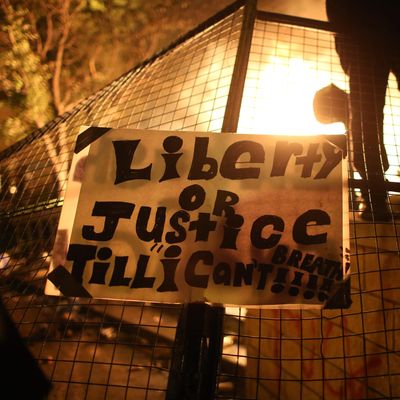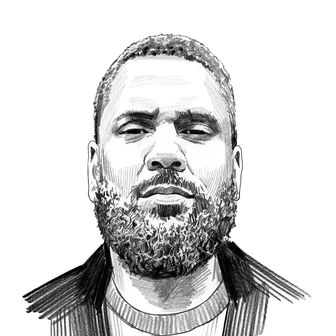
Decades of research and experience show that riots of the kind we’re seeing in Minnesota this week are responses to untenable social conditions. The unrest has been characterized, nevertheless, as inscrutable, and said to delegitimize the grievances that underlie it. Neither is true, but both lines of reasoning help explain the factors that cause riots in the first place.
On Monday night, Minneapolis policeman Derek Chauvin killed George Floyd, reportedly alleged to have committed forgery. The white officer placed the handcuffed black man on his stomach and kneeled on his neck for nine minutes as bystanders gathered and filmed the encounter, some begging Chauvin to relent. Floyd gasped several times that he couldn’t breathe before he appeared to lose consciousness. Chauvin declined to take his knee off his victim’s neck even after the black man went limp and unresponsive. Floyd was pronounced dead at a hospital later that night. Footage of the encounter sparked a national outcry; protests and riots followed. The mayor condemned the killing, and the officers involved were fired. On Thursday and Friday, as prosecutors weighed whether to charge Chauvin with a crime, the unrest escalated: dissidents breached the walls of the 3rd police precinct in Minneapolis, setting the building on fire and prompting its staff to evacuate.
It is important to understand the social context in which these events have occurred. Recent police killings of black men in the Twin Cities region — Jamar Clark in 2015 and Philando Castile in 2016 — provoked demonstrations but no sustained accountability; the officers who killed Clark were neither charged with crimes nor fired, and the officer who killed Castile lost his job but was acquitted of criminal charges. Protests against these outcomes were met with aggression from the state and its sympathizers. A protest camp outside Minneapolis’ 4th police precinct in response to Clark’s death was razed by law enforcement after two weeks of demonstrations and an attempt by white vigilantes to kill its occupants. (Five black men were shot; none died.)
The past several months, meanwhile, have seen American life contract due to the novel coronavirus pandemic; millions of people have lost work, over 100,000 have died, and more than is typical are suddenly struggling to pay bills and rent and feed their families. Black people are disproportionately represented among the crisis’ victims, both epidemiologically and economically. Its heavy toll on their communities makes starker the longstanding reality of black life in cities like Minneapolis, which is defined by residential segregation and the targeted neglect and over-policing that accompany it. Yet even as their and other disadvantaged communities suffer outsizedly, the fortunes of the country’s billionaires have ballooned to the tune of a $434 billion wealth increase since March — a gain of 15 percent, according to CNBC. Enforcing compliance with these inequities, now as ever, has been the responsibility of armed law enforcement, who’ve not only been less affected by the recent social convulsion than most institutions, but enjoyed massive new investments and expanded powers in the bargain.
It’s hard to imagine, without experiencing it, what your personal breaking point is — the point at which the compounding oppressions and indignities expand your understanding of acceptable recourse. Most Americans will never be driven to this point, but those who are look upon a vista of possibilities, that at least bear some hope of changing conditions. Some of these are illegal. Some are destructive. Rarely do they risk matching the depravity to which they are responding.
But pat dismissal, not reckoning, will rule the day. Here are two characteristic repudiations of the Minneapolis unrest, the first from Jon Miller, a journalist, formerly of Fox News and The Blaze: “Why is the reaction to someone’s death to loot a Minneapolis Target? It’s simply an excuse to act like heathens.” And from Charlie Kirk, surrogate for President Trump and president of the conservative advocacy group Turning Point USA: “If you loot, riot, and destroy you lose all moral credibility, in my eyes, to protest injustice.” Neither position is unique to these men or others of their partisan persuasion — each post has been re-shared thousands of times; President Obama expressed a version of Miller’s view when assessing the Baltimore riots in 2015 — and iterations of each are expressed widely whenever such uprisings occur. Nor are they uniquely egregious. The president on Friday morning called for looters to be shot.
Misgivings about rioting are not unusual, and are felt often by people sympathetic to their causes. Among activists and neighbors, this reticence can have a strategic dimension: some worry, often rightly, that rioting will serve as a pretense to ignore their demands, to say nothing of being used as an excuse for escalating police violence. But recent history and decades of scholarship offer answers to the bigger question — why these riots happen at all, and what might be done to prevent them — that people like Miller and Kirk refuse to entertain. The sociopolitical investments that could render them obsolete are known and available. But due to a mix of ideological opportunism and willful dishonesty, some would rather smear people who riot in response to state violence as ungovernable “heathens” and conclude that ending their oppression is contingent on their moral purity — usually as determined, conveniently, by people like Charlie Kirk.
This purity test is redundant. Questioning black people’s fitness for state protection and the right to self-preserve is the American default, not contingent on what black people are actually doing. Nearly a century of research and analysis dating back to the 1930s shows the typical riot involving segregated black communities is carried out not by aberrantly antisocial misfits, but everyday people pushed to the edge by white racism. This was the conclusion reached by researchers into causes of the Detroit riots in 1943, as well as the sweeping Kerner Commission report, which sought to demystify unrest in the late 1960s.
The source of their undertakers’ bafflement and reason for the inquiries wasn’t rooted in the abrupt appearance of riots on the cultural landscape, but in their shifting complexion. Torching, looting, and ransacking properties were common practices in the early decades of the 20th century, but they were almost always carried out by white people, usually to force black people out of predominantly white neighborhoods and into ghettos, or in flare ups of resentment against black economic competition or achievement. Some of their practitioners used alleged black-on-white interracial crimes as pretenses. The 1921 Tulsa massacre is a characteristic incident in a long history of them, resulting in the firebombing of an entire black community and hundreds of deaths. Unlike today, the rationales for these attacks were widely understood and even affirmed by the broader white public; it was only once black victims started fighting back that America’s so-called “race riots” became confusing.
This mystification endures. But when accurately contextualized, it requires no stretch of the imagination to infer why some of the latest unrest entails arson, stealing from stores, and vandalizing buildings with no clear connection to the most obvious manifestations of injustice. For years, agents of the state have telegraphed their lack of interest in protecting black communities in Minneapolis — in no small part because they’re often the entities against whom protection is needed. In turn, people in those communities respond by pillaging the institutions that police expend their capital protecting. (Evidence from past riots points to a sometimes-selective administration of this destruction, where buildings are spared or destroyed depending on their social significance to members of a community.) Put simply, when the state so profoundly undermines its own legitimacy, the cost of responding in kind is defined by new calculations. If a life means nothing, why should a store window or a TV? Indignation, economic desperation, and opportunism mingle in novel and combustible ways.
Those who moralize on this topic often argue that the natural sentence for rioters is for their cause to be ignored. The result is an obfuscation of inequities, with the implied and sometimes stated goal of cultivating oppression. Rudy Giuliani and his ideological ilk have long cited crimes committed by black people against other black people as cause to disregard the severity of racist police violence. Charlie Kirk has been similarly forthright, tweeting that the real problem is that Minnesota elects too many Democrats rather than Republicans like himself — a party that recently sent a white supremacist to the White House. These programs are advanced alongside the more mainstream consensus that to secure justice, black people must prove themselves worthy of it. But this standard can’t be met because it’s arbitrary. Its adherents apply it selectively to rationalize racism. By far the more relevant standard is that eliminating the conditions which allowed Derek Chauvin is not necessary or even desirable to them. They can afford ignorance, dishonesty, delusion. The truth about why riots against state violence happen doesn’t matter if the goal isn’t actually to prevent them.






























